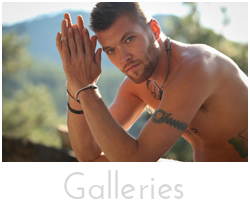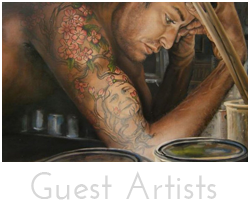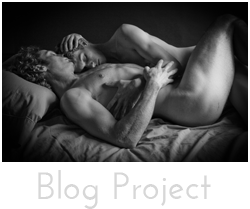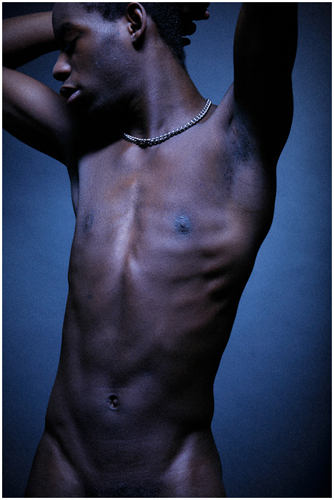 For the past couple of weeks I’ve been working on a series of images using a single light source. I mounted a single light on a boom and suspended it directly above the subjects. I also added just a little bit of spill on the black seamless paper at the back of the wall. Yesterday George came to look at the proofs from last week and I asked if I could use him for a quick test of the light set up to see the results. Everything was locked in where I wanted it, except I forgot to change the color balance back to studio strobe from shooting live theatre the other day. The first shot was stunning, resulting in an amazing mistake, adding a bluish cast to the overall exposure. Theater incandescent lights are rated at a color temperature of 3200K, measured in Kelvin; studio strobes are balance to simulate more of a daylight at about 5500K. The color temperature fluctuates depending on where you are shooting and is something photographers are always aware of when they are working in color. So the way the color temperature works is the lower the number on the chart the warmer the color of the light, for instance candle light is very warm at about 1900K, the higher the number the cooler the color temperature, open daylight can run upwards of about 6500K. Yes, it seems like a contradiction, as so much of photography does, but color temperature is read on an actual scale with the lower numbers actually starting in the red and yellows (warmer) to the higher numbers ending in deeper blues and purples (cooler). The settings on most cameras are now set to a standard icon that represents the closest to that color temperature for the situation you are in and neutralize the color temperature making it appear natural. A light bulb is for incandescent and the clouds for shade, a lighting bolt for strobe. Many new cameras automatically read the temperature and automatically set it.
For the past couple of weeks I’ve been working on a series of images using a single light source. I mounted a single light on a boom and suspended it directly above the subjects. I also added just a little bit of spill on the black seamless paper at the back of the wall. Yesterday George came to look at the proofs from last week and I asked if I could use him for a quick test of the light set up to see the results. Everything was locked in where I wanted it, except I forgot to change the color balance back to studio strobe from shooting live theatre the other day. The first shot was stunning, resulting in an amazing mistake, adding a bluish cast to the overall exposure. Theater incandescent lights are rated at a color temperature of 3200K, measured in Kelvin; studio strobes are balance to simulate more of a daylight at about 5500K. The color temperature fluctuates depending on where you are shooting and is something photographers are always aware of when they are working in color. So the way the color temperature works is the lower the number on the chart the warmer the color of the light, for instance candle light is very warm at about 1900K, the higher the number the cooler the color temperature, open daylight can run upwards of about 6500K. Yes, it seems like a contradiction, as so much of photography does, but color temperature is read on an actual scale with the lower numbers actually starting in the red and yellows (warmer) to the higher numbers ending in deeper blues and purples (cooler). The settings on most cameras are now set to a standard icon that represents the closest to that color temperature for the situation you are in and neutralize the color temperature making it appear natural. A light bulb is for incandescent and the clouds for shade, a lighting bolt for strobe. Many new cameras automatically read the temperature and automatically set it.
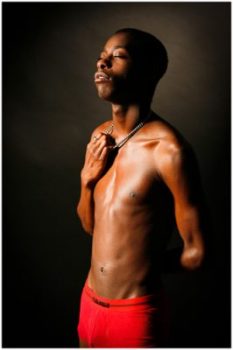 So anyway, once we saw the result on George’s skin tones, we became very excited and began to explore the possibilities for about 20 minutes as he began to strip down so I could see how it was affecting his skin tones. The images are simple and the color works beautifully with his dark skin tones. It was a happy mistake. Sometimes we have to think outside the parameters of where we normally work. I tend to not work outside of them too much because I pretty much know where I want the final images to go, but when I was younger I did a lot of experimentation to understand all the possibilities, but then as we got older we tend to gravitate toward what eventually becomes our signature style, and we just begin to refine it. I tend to always shoot my images with just a slightly warmer color temperature than normal, which I have calibrated into my camera, because it feels a little richer and becomes more romantic and I love what it does to the skin tones and it also turned my gray walls into a warm greenish glow. It takes years to come up with a style to match your own personality and vision; but today I have moved in another direction. I will play with it and see what happens.
So anyway, once we saw the result on George’s skin tones, we became very excited and began to explore the possibilities for about 20 minutes as he began to strip down so I could see how it was affecting his skin tones. The images are simple and the color works beautifully with his dark skin tones. It was a happy mistake. Sometimes we have to think outside the parameters of where we normally work. I tend to not work outside of them too much because I pretty much know where I want the final images to go, but when I was younger I did a lot of experimentation to understand all the possibilities, but then as we got older we tend to gravitate toward what eventually becomes our signature style, and we just begin to refine it. I tend to always shoot my images with just a slightly warmer color temperature than normal, which I have calibrated into my camera, because it feels a little richer and becomes more romantic and I love what it does to the skin tones and it also turned my gray walls into a warm greenish glow. It takes years to come up with a style to match your own personality and vision; but today I have moved in another direction. I will play with it and see what happens.

